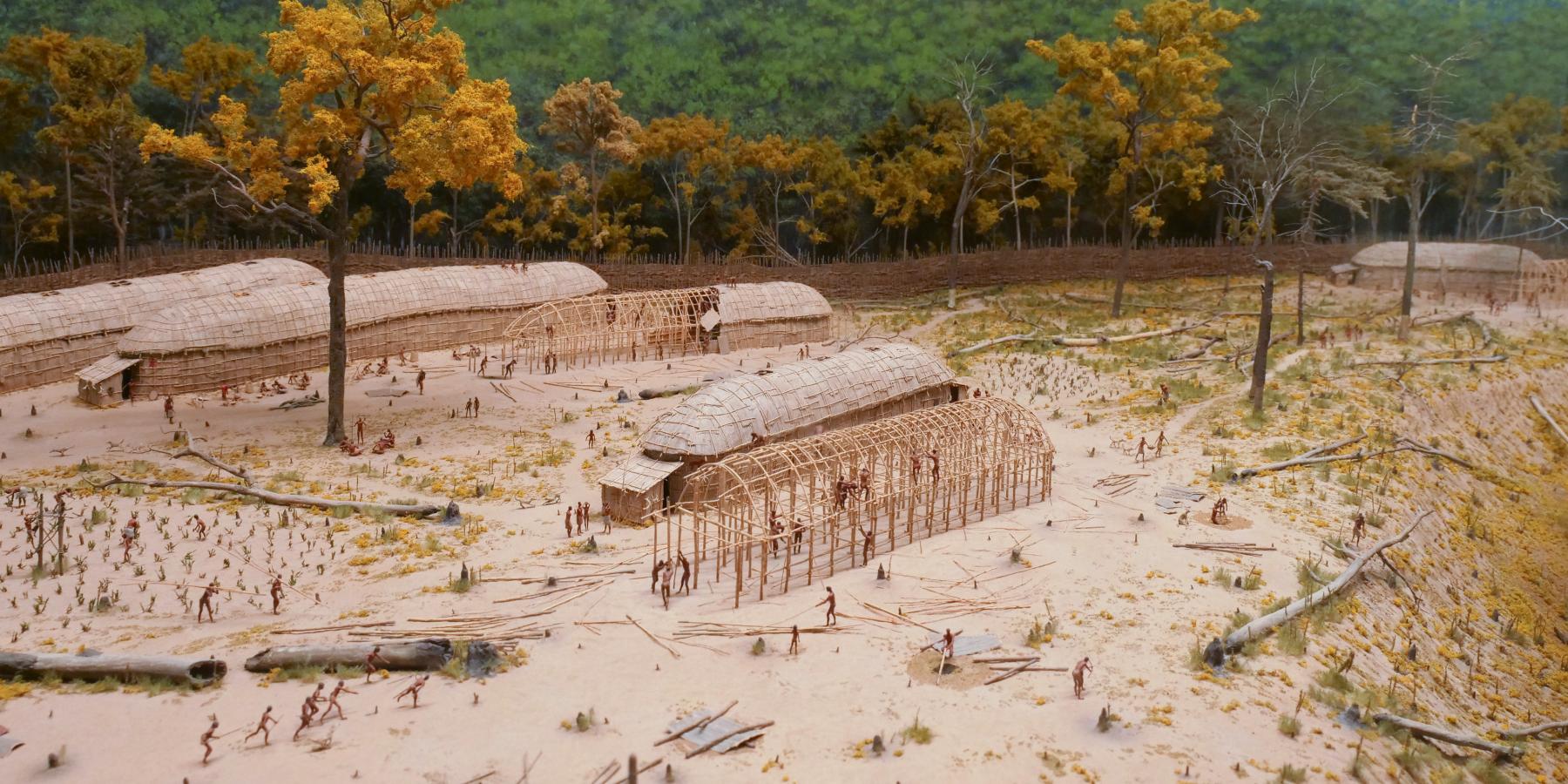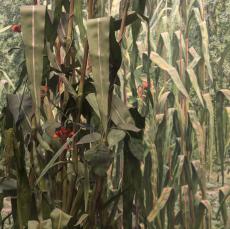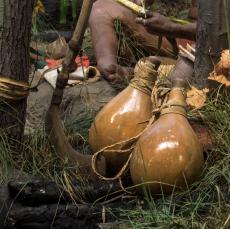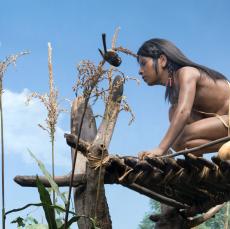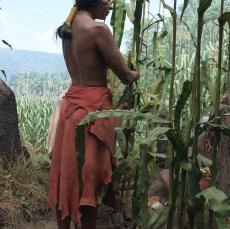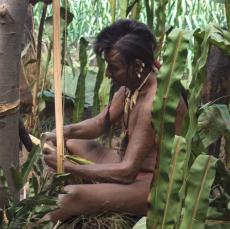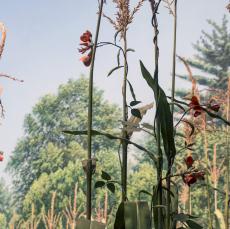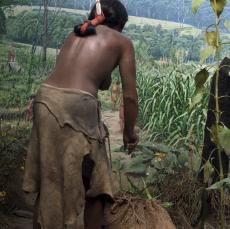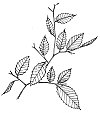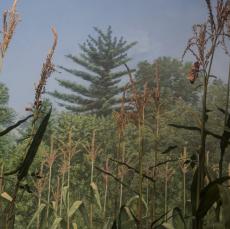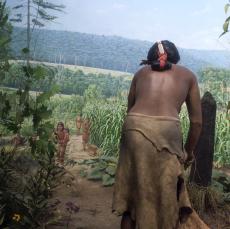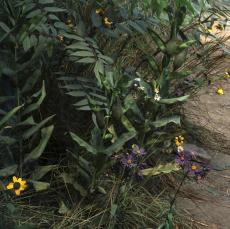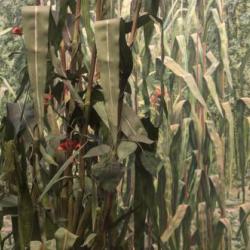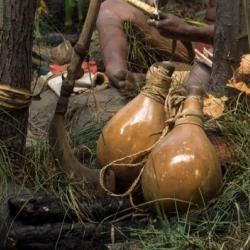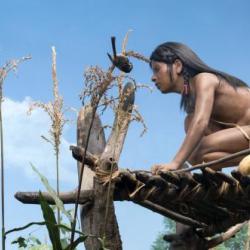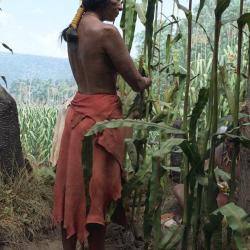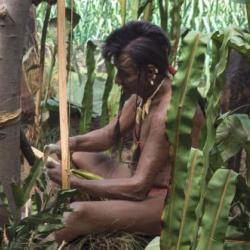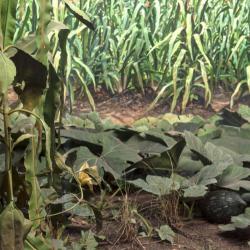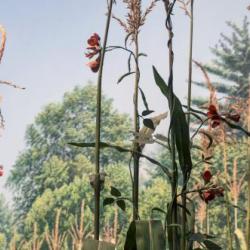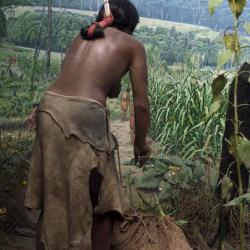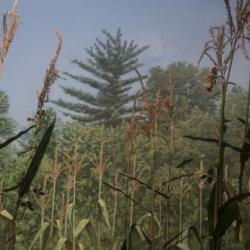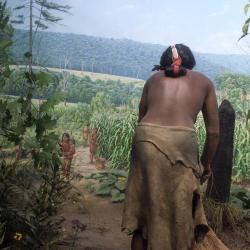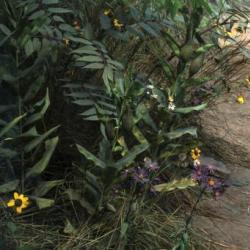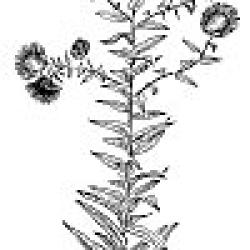The Three Sisters Diorama
Collectively referred to as "The Three Sisters," corn, beans, and squash were the principal crops of the Haudenosaunee (Iroquois) and other Native American groups in the northeastern United States, at the time Europeans arrived here about 1600. By this time, the Haudenosaunee had been planting these three crops together for about 300 years. Corn and beans are not native to this area; they originated in tropical America where they were cultivated by early peoples, long before these crops were cultivated in the northeastern United States. Pumpkins and similar types of squash have a tropical origin, as well.
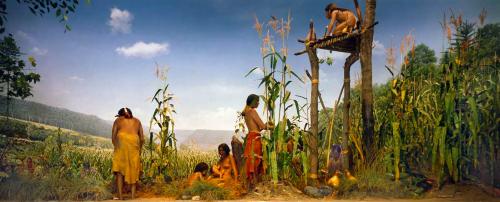
The Scene
The scene is in the Mohawk Valley about 30 miles west of the confluence of the Mohawk and Hudson rivers near Troy, N.Y. The view is to the southeast toward the Mohawk River where it flows through a narrows called the Noses, several miles west of Fonda, N.Y. The setting is a day in late August when the corn is beginning to mature. This is the time of the Green Corn Festival, one of the Iroquois' days of thanksgiving.
The earliest evidence of corn cultivation in New York is by 1200 years ago (A.D. 800) and beans, about 500 years later (A.D. 1300). The tropical varieties of squash did not enter the Northeast until about 1000 years ago (A.D. 1000). Some other types of squash originated in the eastern U.S.; they were cultivated in the Northeast by at least 2700 years ago (700 B.C.).
Cultivation of crops, gradually brought about a change in the Haudenosaunee way of life from hunting and gathering their sustenance in the woodlands, to cultivating crops in fields created by clearing patches of woodland. However, the Haudenosaunee had cultivated plants native to the Northeast long before 'The Three Sisters' became the basis of their economy. Native plants were not only sources of food but also provided medicines, beverages, dyes, etc. We know very little detail about these earlier agricultural practices.
The development of farming brought about the development of 'permanent' villages linked to the fields. Women, who did the farming, then lived year-round in the villages. This arrangement was established at least three hundred years before European arrival.
Highlighted Scenes within the Diorama
Haudenosaunee corn at this 'green corn' stage is similar to our sweet corn and is ready to eat. The Haudenosaunee used some of the crop at Green Corn Festival time, but most was left to ripen and was harvested in the fall. Ripe corn was dried and stored for winter use.
The silk on the ear of corn in the photo indicates that this ear is nearly ready to pick as green corn, but wait another day or two until the silk becomes a little drier and darker brown.
The tool with the long handle and curved blade is a replica of one described in the 1620s, as a wooden hoe used in cultivation. It was pictured in a French missionary's report in 1685. It's hard to imagine how it works. It is commonly believed that the Haudenosaunee used the shoulder blades of deer as hoes.
Corn, beans and squash were commonly planted together in the same 'hill'. After the corn plants are growing, soil is piled up around their stalks to help keep them upright in the wind. Women did the farming, assisted by children, and at harvest time, by old men. Weeding was important to help the crops thrive and to keep the forest from encroaching into the fields.
The old man is scraping the kernels from an ear of corn with the teeth and jawbone of a deer. The corn will drop into a vessel made from the bottom part of a large gourd. Gourds were used as vessels for various purposes. None are shown growing in the exhibit, but the Haudenosaunee did cultivate them.
Cultivated Plants and Fields
The Haudenosaunee crops required well-drained soil with a high lime content.
A good growing area could be recognized by the kind of forest growing there. In addition, the soil had to be easy to work because the tools of the time were made of stone, antler, bone, and wood.
In a virgin forest, the trees were huge and widely spaced. Such trees were killed by girdling, a process that allowed sunlight to reach the forest floor; then crops could flourish. The dead trees were left to rot or burn. Annual burning cleared the fields of weeds and stubble.
The soil became exhausted after a decade of farming, so the fields were abandoned. The forest reclaimed the land and rejuvenated the soil, which prepared it for another cycle of farming after 50 or 60 years. The people got a great bonanza of trees small enough for their construction projects when they cleared this second-growth forest for new fields. This time they felled the trees and burned the unwanted brush.
Forest Trees in the Background Painting of the Diorama
The background represents a beech-maple forest named for two of the more abundant kinds of trees found in it, American beech and sugar maple. White ash, American basswood, pignut hickory, shagbark hickory, white pine, yellow birch, hemlock, American elm and sweet birch are other trees commonly found in this type of forest. The Iroquois had learned that this type of forest grew on a fertile soil that would be good for their crops. Similar forests grow in the region today.
When your are at the exhibit, notice that the trees in the background painting are not large, and that they are close together. This is a second growth forest about 50 years old. This new forest invaded an earlier field, which was abandoned because the soil had been depleted by farming. The new forest growth restores the fertility to the soil, and trees of this size are ideal for longhouse construction.
'Weed' Plants in Bloom
Sketches of Weed Plants in the Diorama
 purple aster (Aster novae-angliae)
purple aster (Aster novae-angliae)mature plant is 2 - 4 feet in height
 black-eyed Susan or cone flower (Rudbeckia triloba)
black-eyed Susan or cone flower (Rudbeckia triloba)mature plant is 2 - 4 feet in height
 evening primrose (Oenothera biennis)
evening primrose (Oenothera biennis)mature plant is 1 - 5 feet in height
 white daisy or fleabane (Erigeron annuus)
white daisy or fleabane (Erigeron annuus)mature plant is 1 - 3 feet in height
 goldenrod (Solidago canadensis)
goldenrod (Solidago canadensis)mature plant is 2 - 4 feet in height
 common milkweed (Asclepias syriaca)
common milkweed (Asclepias syriaca)mature plant is 1 1/2 - 4 feet in height
 May apple (Podophyllum peltatum)
May apple (Podophyllum peltatum)mature plant is 1 - 2 feet in height
 wild strawberry (Fragaria virginiana)
wild strawberry (Fragaria virginiana)mature plant is 4 - 8 inches in height
 staghorn sumac (Rhus typhina): a twig with several compound leaves
staghorn sumac (Rhus typhina): a twig with several compound leavesmature shrub is up to 15 feet in height
 little blue stem grass (Schizachyrium scoparium)
little blue stem grass (Schizachyrium scoparium)mature plant is 1 - 2 1/2 feet in height
Not illustrated: crabgrass (Digitaria sanguinalis) -- badly trampled specimens in the foreground of the diorama.
(When you visit the Museum, you might take along a copy of these plant pictures to help identify the plants in the diorama)
The Three Sisters Diorama
Collectively referred to as "The Three Sisters," corn, beans, and squash were the principal crops of the Haudenosaunee (Iroquois) and other Native American groups in the northeastern United States, at the time Europeans arrived here about 1600. By this time, the Haudenosaunee had been planting these three crops together for about 300 years. Corn and beans are not native to this area; they originated in tropical America where they were cultivated by early peoples, long before these crops were cultivated in the northeastern United States. Pumpkins and similar types of squash have a tropical origin, as well.
The Scene
The scene is in the Mohawk Valley about 30 miles west of the confluence of the Mohawk and Hudson rivers near Troy, N.Y. The view is to the southeast toward the Mohawk River where it flows through a narrows called the Noses, several miles west of Fonda, N.Y. The setting is a day in late August when the corn is beginning to mature. This is the time of the Green Corn Festival, one of the Iroquois' days of thanksgiving.
The earliest evidence of corn cultivation in New York is by 1200 years ago (A.D. 800) and beans, about 500 years later (A.D. 1300). The tropical varieties of squash did not enter the Northeast until about 1000 years ago (A.D. 1000). Some other types of squash originated in the eastern U.S.; they were cultivated in the Northeast by at least 2700 years ago (700 B.C.).
Cultivation of crops, gradually brought about a change in the Haudenosaunee way of life from hunting and gathering their sustenance in the woodlands, to cultivating crops in fields created by clearing patches of woodland. However, the Haudenosaunee had cultivated plants native to the Northeast long before 'The Three Sisters' became the basis of their economy. Native plants were not only sources of food but also provided medicines, beverages, dyes, etc. We know very little detail about these earlier agricultural practices.
The development of farming brought about the development of 'permanent' villages linked to the fields. Women, who did the farming, then lived year-round in the villages. This arrangement was established at least three hundred years before European arrival.
Highlighted Scenes within the Diorama
Haudenosaunee corn at this 'green corn' stage is similar to our sweet corn and is ready to eat. The Haudenosaunee used some of the crop at Green Corn Festival time, but most was left to ripen and was harvested in the fall. Ripe corn was dried and stored for winter use.
The silk on the ear of corn in the photo indicates that this ear is nearly ready to pick as green corn, but wait another day or two until the silk becomes a little drier and darker brown.
The tool with the long handle and curved blade is a replica of one described in the 1620s, as a wooden hoe used in cultivation. It was pictured in a French missionary's report in 1685. It's hard to imagine how it works. It is commonly believed that the Haudenosaunee used the shoulder blades of deer as hoes.
Corn, beans and squash were commonly planted together in the same 'hill'. After the corn plants are growing, soil is piled up around their stalks to help keep them upright in the wind. Women did the farming, assisted by children, and at harvest time, by old men. Weeding was important to help the crops thrive and to keep the forest from encroaching into the fields.
The old man is scraping the kernels from an ear of corn with the teeth and jawbone of a deer. The corn will drop into a vessel made from the bottom part of a large gourd. Gourds were used as vessels for various purposes. None are shown growing in the exhibit, but the Haudenosaunee did cultivate them.
Cultivated Plants and Fields
The Haudenosaunee crops required well-drained soil with a high lime content.
A good growing area could be recognized by the kind of forest growing there. In addition, the soil had to be easy to work because the tools of the time were made of stone, antler, bone, and wood.
In a virgin forest, the trees were huge and widely spaced. Such trees were killed by girdling, a process that allowed sunlight to reach the forest floor; then crops could flourish. The dead trees were left to rot or burn. Annual burning cleared the fields of weeds and stubble.
The soil became exhausted after a decade of farming, so the fields were abandoned. The forest reclaimed the land and rejuvenated the soil, which prepared it for another cycle of farming after 50 or 60 years. The people got a great bonanza of trees small enough for their construction projects when they cleared this second-growth forest for new fields. This time they felled the trees and burned the unwanted brush.
Growing corn and beans together is good practice: the corn stalk provides a trellis for the beans AND the roots of the bean plants nourish the corn by fixing nitrogen in the soil, which is depleted by the corn.
The corn and bean plants in the exhibit are plastic replicas of plants grown by modern-day Haudenosaunee. The seeds were passed down from the 1600s through many generations of crops.
The plants that resemble small sunflowers are Jerusalem artichokes (Helianthus tuberosus), a plant native to the Mississippi Valley. The Haudenosaunee grew this plant for its tuberous 'roots', which somewhat resemble potatoes.
Early European visitors took this plant home where it became a popular food.
Fernald and Kinsey, in their book, Edible Wild Plants of Eastern North America, tell us that: "The name Jerusalem applied to this plant is likely to lead to misconception. The tubers, early introduced into Europe, were soon popular in the Mediterranean countries and in Spanish were called girasol, in Italian girasole. True to their genius in such matters the English promptly changed it to Jerusalem."
Girasole translates to 'turning to the sun'.
Forest Trees in the Background Painting of the Diorama
American beech
The background represents a beech-maple forest named for two of the more abundant kinds of trees found in it, American beech and sugar maple. White ash, American basswood, pignut hickory, shagbark hickory, white pine, yellow birch, hemlock, American elm and sweet birch are other trees commonly found in this type of forest. The Iroquois had learned that this type of forest grew on a fertile soil that would be good for their crops. Similar forests grow in the region today.
Sugar maple
When your are at the exhibit, notice that the trees in the background painting are not large, and that they are close together. This is a second growth forest about 50 years old. This new forest invaded an earlier field, which was abandoned because the soil had been depleted by farming. The new forest growth restores the fertility to the soil, and trees of this size are ideal for longhouse construction.
'Weed' Plants in Bloom
These 'weed' plants, which are in the left foreground of the diorama, include some of those found in the area today in late August. Several are shown in bloom for artistic effect; however, in nature, all of these might not be in bloom at the same time, but all bloom in the late summer. All are native plants, but today they would not be the dominant weeds at the edge of a field. Most of our present-day weed plants are immigrants from Europe and Asia.


